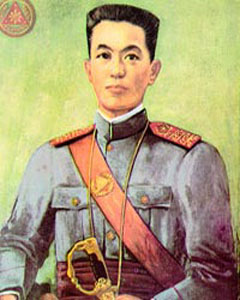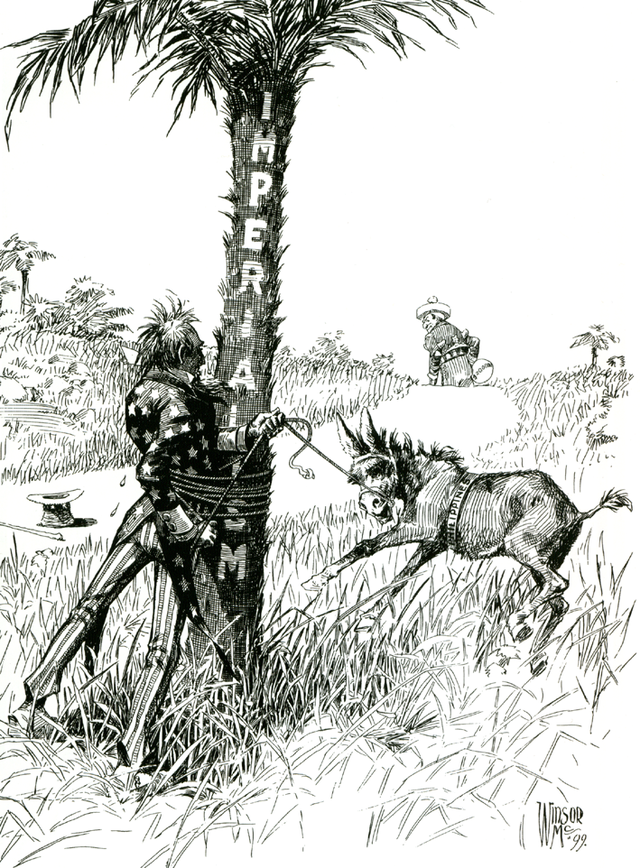The Blood of Government
by Paul Kramer
The Progressive Era & WWI
Military and Foreign Policy
Ethnicity and Race
Thesis:
Kramer argues that the US involvement in the Phillippines and colonial mother country status was inextricably linked to racist sentiment.
Specific examples/evidence that supports the
thesis:
Despite the Filipino people repeatedly displaying their aptitude for self-rule, America refused to grant independence and colored them as backwards an uncivilized. The evidence strongly supports his thesis. The Filipino people were highly educated and politically had learned a great deal from serving in the colonial government with Spain. They were much more civilized than they were given credit for. Minority populations (like extinct headhunters) were used to demonstrate the uncivilized nature of Filipinos and justify US involvement.
Summary:
Despite the rare discussion about the American Filipino War, it is a vastly significant moment in U.S. history. This war gave birth to the American Empire and brought American into competition with the world powers.
American military came into the Philippines under the pretense that they would help them establish independence from Spanish rule. The Philippine Revolution began in 1896, to gain sovereignty from the Spanish.
Despite the rare discussion about the American Filipino War, it is a vastly significant moment in U.S. history. This war gave birth to the American Empire and brought American into competition with the world powers.
American military came into the Philippines under the pretense that they would help them establish independence from Spanish rule. The Philippine Revolution began in 1896, to gain sovereignty from the Spanish.
 Aguinaldo was a Filipino revolutionary that rose to lead the independence movement in 1796, eventually he negotiated assistance from US Navy Commander Dewey only to be manipulated into an alliance that led to a trade of imperial overseers instead of independence. Eventually he became a hero of Filipino people because of his commitment to gain independence.
Aguinaldo was a Filipino revolutionary that rose to lead the independence movement in 1796, eventually he negotiated assistance from US Navy Commander Dewey only to be manipulated into an alliance that led to a trade of imperial overseers instead of independence. Eventually he became a hero of Filipino people because of his commitment to gain independence.
The Filipino ambassadors petitioned the world to support independence.
During Spanish occupation the Filipinos developed their education and began to lay the foundation for independence with more leaders in the colonial government and highly educated mestizo class.
The African American treatment in America made Filipinos weary of American occupation, fearing they would be turned into a slave class.
Eventually some of the revolutionaries attacked the occupying American forces giving them the perfect opportunity to declare war on the savage, uncivilized people who needed proper government and education provided for them, as they would never be able to do it themselves. (A common excuse for imperialism)
Racism played a major role in the war. Soldiers called Filipinos "niggers" and abused, tortured, and killed them far outside the rules of civilized warfare. Their defense was that the race was lesser and could not be fought using normal civilized rules of combat. Torture was often used by Americans as pictured below...

During the ongoing war with the Philippines, the US decided to exhibit their new colony in the Pan-American Expo to show the world that they were an empirical power and to show that they were participating in civilizing the world.
The
With American colony status established, the officials went about educating the Filipinos in American history and world supremacy, painting Americans and Filipinos as brothers. Of course America as the older brother, showing them the way of the world. Policy went about saying that once the Filipino people were capable of self rule, it would be given to them. In fact, this was America's way to justify their presence as benevolent and not made up of self-interest. As time went on, the Filipino people proved themselves time and again ready for independence. Not wanting to fuel the fire of the uncivilized claim, the desire for independence was repeatedly presented politically to the heads of state who always agreed that when they were ready, independence would be granted.
In 1916, The Jones Act gave Filipinos more representation in their own government and assured them that independence was the US goal for them.
Eventually the Filipino cause gained ground in the US but only by those threatened by the cheap Filipino exports and or the labor provided by Filipinos who came to America under policies that allowed for their immigration because they are citizens of a colony, also the nativist sentiment that wanted to exclude any people of Asiatic decent from entering the country and or gaining citizenship. It was only after WWII and the end to the Japanese occupation of the Philippines that the US finally agreed to independent status of the Philippines.

What does this tell us about Military and Foreign Policy in the The Progressive Era/WWI?
America's colonial interest was driven mostly by a desire to be viewed as a world power after industrializing. American's also saw themselves as a special people who's democratic freedom loving christian lifestyle should be spread to the less fortunate (manifest destiny extended). Spreading dominion to the Pacific made sense because it gave America a strong hold in Asia.
Foreign policy towards undeveloped countries was much like the rest of the industrialized world at this time, COLONIZE under the guise of humanitarian intentions. This was especially true in the Philippines, where America came in to "help Filipinos establish their independence from Spain."
America's colonial interest was driven mostly by a desire to be viewed as a world power after industrializing. American's also saw themselves as a special people who's democratic freedom loving christian lifestyle should be spread to the less fortunate (manifest destiny extended). Spreading dominion to the Pacific made sense because it gave America a strong hold in Asia.
Foreign policy towards undeveloped countries was much like the rest of the industrialized world at this time, COLONIZE under the guise of humanitarian intentions. This was especially true in the Philippines, where America came in to "help Filipinos establish their independence from Spain."
What does this tell us about Ethnicity and Race in the The Progressive Era/WWI?
The way the American's treated the Filipinos in the colony as opposed to in America demonstrates the real ethnic racism taking place in America. Many of the soldiers who went to the Philippines after the colonial government had been installed, found that Filipinos were often well educated and intelligent, calling them their little brown brothers. In America, on the other hand, Filipinos were generally considered in the same class as the Chinese and Japanese who experiences the worst atrocities of racism. They found it hard to get jobs, did not receive a fair wage, couldn't get housing, and sometimes were the victims of violence. Americans campaigned against Filipinos who they claimed took their jobs and had an affinity for white women.
The way the American's treated the Filipinos in the colony as opposed to in America demonstrates the real ethnic racism taking place in America. Many of the soldiers who went to the Philippines after the colonial government had been installed, found that Filipinos were often well educated and intelligent, calling them their little brown brothers. In America, on the other hand, Filipinos were generally considered in the same class as the Chinese and Japanese who experiences the worst atrocities of racism. They found it hard to get jobs, did not receive a fair wage, couldn't get housing, and sometimes were the victims of violence. Americans campaigned against Filipinos who they claimed took their jobs and had an affinity for white women.
What parts of the book can be applied to lectures?
General Thoughts:
The author argues that the colonial relationship with the Philippines drastically changed the United States as people were exposed to an Asianic other that proved to be civilized and educated and not fit into the racist stereotypes so embedded in American popular culture at that time. While I agree that the people who had intimate interactions with the majority of Filipino colonial immigrants or those the military interacted with in the Philippines were changed by the relationships, the average American just lumped Filipinos in with the other Asian peoples and their stereotypes remained strong. This book did not provide significant evidence to support the idea that Americans as a whole followed suit, it was the minority who appreciated and supported the Filipino cause for the right reasons.
Excerpts from Book Reviews:
My Highlighted Passages:
Exiled revolutionaries were
divided and willing to play both sides. The end of April 1898 saw Miguel Malvar
in Hong Kong negotiating with Spaniards for autonomy and Emilio Aguinaldo in
Singapore negotiating with a U.S. consul for recognition of Philippine independence.1226
By Aguinaldo's account, Wood
had stated that the United States was "a great and rich nation and neither
needs nor desires colonies";1229
Aguinaldo claimed Dewey had
honored him as a general, urged the lifting of a Philippine flag, and promised
U.S. recognition of Philippine independence.1251
Aguinaldo appointed diplomatic
emissaries to travel to European capitals and to Washington to lobby for the
recognition of the Philippine Republic.1334
These agents launched legal and
historical arguments for the sovereignty of the Philippine Republic and the impossibility
of the islands' legitimate transfer from Spain to the United States.1335
when Filipinos were "told
of America's treatment of the black population," they were "made to
feel that it is better to die fighting than to become subject to a nation
where, as they are made to believe, the colored man is lynched and burned alive
indiscriminately." 551394
Some black leaders made the
still more controversial move of declaring solidarity or even identity with
Filipinos.1594
derecognition to its furthest
extension: Filipinos had already "caused so much trouble & murdered so
many of our boys" that U.S. soldiers "recognize them no longer but
shoot on sight all natives.1900
"I wish you to kill and
burn." Smith ordered "all persons killed who are capable of bearing
arms in actual hostilities against the United S
tates," When Waller had asked the general for clarification,
Smith stated that he considered any person over the age of ten "capable of
bearing arms,"1922
The direct result of these
instructions was systematic destruction and killing on a vast scale.1923
Race would not only justify the
ends of the war-especially as the necessary response to Filipino savagery and
tribal fragmentation-but would be used to justify many of the "marked
severities" employed by U.S. soldiers to bring it to its desired
conclusion. 1928
Those who adopted guerrilla
war, it was argued, surrendered all claims to bounded violence and mercy from
their opponent.1942
the report had concluded that
Aguinaldo, who had never been guaranteed American support, had provoked
a war with the United States in the name of a falsely named
"republic";2437
Viewed from the perspective of
Philippine colonial officials, the exposition failed to accomplish its three
principal political goals: to convince the American public of civilian control
and the terms of assimilation; to promote Philippine exports through tariff
reform; and to persuade elite Filipinos of U.S. power and good intentions.3392
The racial-political angst of
these anti-imperialists reflected a profound truth: that the very racial
formations upon which American politics was grounded at that moment were
themselves plastic.5605
Like other empires, the United
States had gone out into the world in the twentieth century, only to find
itself remade by it.5612
Long after the end of formal U.S. imperial sovereignty,
struggles over the terms of Philippine-American colonialism, embedded in
Philippine and U.S. national and racial formations, would continue to haunt the
way each society approached its global history. 5613
No comments:
Post a Comment